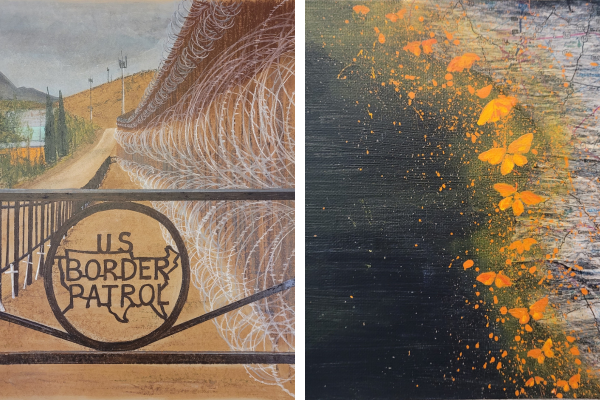
Landscapes and Lives Partitioned: Witnessing the Borderlands by Shelley K White on view in the RSM Art Gallery
January 17, 2024
Landscapes and Lives Partitioned: Witnessing the Borderlands
Shelley K White
January 16–February 24, 2024

OPENING RECEPTION & EVENTS
January 24
Artist Talk & Opening Reception at RSM Gallery
talk begins at 5:00 p.m. followed by reception 5:30-7:00 p.m.
January 30
MLK: Day of Social Justice, Celebration, Listening and Learning community conversation
Constructing Borders: Stories from Time Spent On the US-Mexico Border
10:45 a.m.–12:00 p.m. at RSM Gallery
February 9
Tile Art Workshop
3:00–5:00 p.m. at Collins Creative Corner
RSVP: email Danielle Krcmar
February 14
US-Mexico Borderlands: A Political Economy of Border Militarization
2:00–3:20 p.m. at Morison 101, BSLCE Social Justice Lounge
RSVP required: email Bria Milbery
ABOUT THE EXHIBIT
The RSM Gallery is pleased to present Landscapes and Lives Partitioned: Witnessing the Borderlands, an Installation by Shelley K White, January 16- February 24, 2024. On Wednesday, January 24, there will be an artist's talk at 5:00 pm, followed by a reception at 5:30 pm.
How does one bear witness to the continuing humanitarian crisis unfolding day by day at the US-Mexico Border? How do you help rewrite a highly politicized narrative so that migrants arriving at this border from over 100 countries around the world are seen as fully human and not as a cause for fear? Shelley K White contends with these questions as an educator, artist, and activist. Her exhibition, Landscapes and Lives Partitioned: Witnessing the Borderlands uses painting, drawing, printmaking, bookmaking, and an interactive memorial sculpture as a means of drawing our attention to the harm, history, and potential for hope at our southern border.
The exhibition features an ambitious large-scale libretto composed of 9 chalk pastel drawings outlining a history of the US – Mexico border’s delineation and militarization. Each page is 4 ½ feet tall and the complete length of the libretto measures 22 ½ feet when fully unfolded. The vulnerability of the pastel and the human touch present in the drawings contrast with and emphasize the immense unwieldiness of the libretto and the starkness of the images of the border wall. White has printed copies of the libretto, an homage to Gloria Anzaldúa’s poem El Otro México, as handheld books which include her own poem A Lament for the Borderlands. The viewer is encouraged to read the book in the gallery and take it home with them as both a remembrance and a call to action.
As part of a memorial work that mirrors memorials held in Southern Arizona, viewers will be invited to carry one or more stones into the gallery and place them on blankets in the center of the gallery in remembrance of a life lost in the borderlands of Southern Arizona. Over the course of the exhibit, 4,093 stones will be placed in the center of the gallery to represent recorded migrant deaths in this region since 1999.
The Monarchs and Maps painting series finds inspiration and hope in the 3,000-mile multi-generational migrations of the monarch butterflies. In their annual migration, monarchs fly across the borders of Canada, The US, Mexico, and back again, pollinating plants as they go and thus supporting the food security of humans. The paintings contrast the flowing flight paths of the monarchs with the delineations imposed on the maps, inviting the viewer to imagine different ways of moving, and allowing movement, in the world.
Shelley K White is a professor of public health, artist, and activist who focuses on social and environmental injustices connected to economic globalization, structural racism, climate crisis, and US-led militarization. Over recent years her work has centered on the Southern Arizona/northern Sonora borderlands where she partners with organizations working towards migration justice, environmental restoration, and liberatory education. Her art grapples with identity, complicity, and the complexity of bearing witness in a global political economy built on the disposability of people and planet. Prominent themes in her visual art and creative writing include our collective disconnection from and disregard of nature, physical and metaphorical walls compounding social divides, the materials economy that has hollowed out social meaning, and the insidiousness of coloniality. She uses painting, drawing, mixed media collage, and sculpture with found objects and waste materials, as well as poetry, song, and creative writing. Her work both celebrates the beauty of our remaining social network and natural environment and depicts realist scenes of division and destruction. While her art offers space for processing loss at both personal and collective levels, it also offers the hope and possibilities of systems change.
